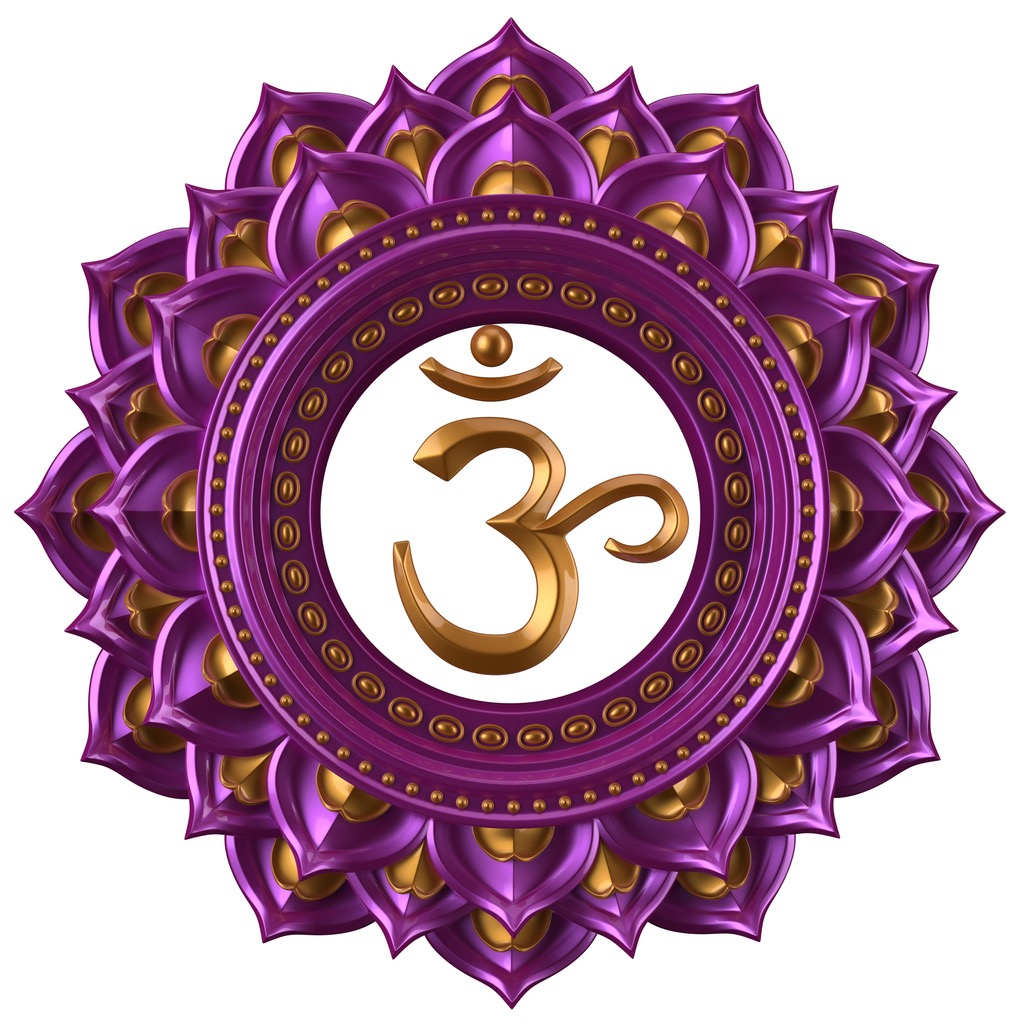In my last blog entry, The Chakra Chronicles, Part 1, I offered an introduction to the energy centers of the body known as the chakras (wheels). We began with the first four: root (Muladhara), sacral (Svadhisthana), solar plexus (Manipura), and heart (Anahata). This entry will complete our introduction of the chakras and also introduce the main energy channels (Nadis) that run along and around the spine.*
*based on the Hindu chakra system. It is important to note that this is not to be considered a comprehensive writing. There is a wide variety of energetic anatomy systems and much more information about these systems than can be included in an introductory blog post.

Vishuddha Chakra
We continue with the fifth chakra, known as Vishuddha chakra in Sanskrit. Located in the throat, its yantra (symbol) is a sixteen-petaled, blue lotus containing a small circle, representing the moon, inside a downward-facing triangle and it is associated with the element of ether/space – sometimes referred to as the container of the other four elements. The throat is our center of communication and in particular, governs speaking one’s truth. Vishuddha chakra’s sense is hearing, since listening, as well as speaking, are both part of communication. The thyroid gland and parathyroid glands are governed by the throat chakra, as well as the mechanical body parts associated with communication, such as the vocal cords, throat, mouth and ears. Imbalances in this chakra manifest as chronic throat issues like laryngitis/tonsillitis, recurrent sore throats, thyroid conditions, ear/hearing conditions, etc.
Vishuddha chakra is the last chakra associated with any of the five senses or elements. It is the place where we transition and move upward to the chakras of intuition and spirituality. Therefore, it is believed we must speak our truth in order to make the transcendence to the chakras of higher consciousness.
In our yoga practice, we activate and balance Vishuddha chakra by opening the throat and strengthening the neck through back-bending, throat opening postures and poses that have the shoulders as a foundation. Another way to balance the throat chakra is by chanting or singing. Sacred chant has both a meditative and a centering effect on the being – singing brings joy to the heart while it serves to warm the throat mechanically and open it energetically. Both practices balance Vishuddha chakra and open the gateway to the upper two.

Ajna Chakra
Ajna chakra is located at the third eye space, in the center of the forehead just above the brows. The sixth chakra is not associated with any sense or element and its color is indigo or violet. Its yantra is a two-petaled lotus, with a downward-facing triangle inside a circle. It is transparent and made of light. Its purpose is to help us “see” clearly – to look beyond the veil of illusion (Maya) and see what is truly real. Ajna is the place where we move beyond identifying with a world of physical matter to the subtle, energetic world of higher consciousness.
Ajna governs the pituitary gland and the eyes. The place of sight, as well as insight, this is the home of our intuition. (It is important to remember that Manipura chakra, at the solar plexus (navel center), has a special relationship with insight and the eyes as well.) Higher perception and thinking are developed at the third eye and it is activated nearly exclusively through meditation. There are gentle ways to wake the third eye but true development occurs through practicing Pratyahara (sense withdrawal), Dharana (concentration), and Dhyana (meditation).
Ajna is where duality ends. Ideas such as I/you, right/wrong, good/bad, etc. begin to dissolve so we can have an experience of unity and connection with everything and everyone around us. Governed by Shiva, the lord of destruction, this chakra influences the subtle mind and teaches us how to control our desires and attachments. Hakini Shakti rules with Shiva – she has six heads which represent enlightenment, thought control, concentration, meditation, superconscious concentration and undivided attention. (Again, those aspects we activate through meditation practice.)

Sahasrara Chakra
Sahasrara chakra is the seventh chakra at the crown of the head – located at the fontanel, the “soft spot” on a baby’s skull. Notice that when we are born this energy center is open. Over time it closes, although not entirely. The skull bones are connected by sutural joints, flat bones meeting and connected by fibrous tissue, which allows for small movement at those joints and a softer, more pliable skull. Meditation and yoga practices are believed to keep Sahasrara open, thereby keeping us open to higher wisdom and inner guidance. These practices also help to balance the male and female energies in the body and elevate them to Sahasrara, where they merge.
Sahasrara chakra’s yantra is the thousand-petaled lotus, which contains an OM (sometimes not) and is usually depicted as violet or white (sometimes gold). These petals represent the fifty letters of the Sanskrit alphabet and their twenty permutations (layers). Sahasrara is beyond the senses, sense organs, and elements, and is unique in several ways. One is that the other six chakras feature upward-facing lotuses – Sahasrara’s points downward. This is symbolic of transcending the dense matter below and receiving the blessing of divine rain as it drips down the petals, washing us over with the “dew of Divinity”.
When we have opened and balanced Sahasrara, the individual “I”, the small self, fades into Wholeness, and we live in Samadhi (bliss) as an embodiment of “self” and “Self” simultaneously. Ideally, this union invites healthy detachment from Prakriti (matter) as we observe the world from the perspective of Purusha (consciousness manifest) and embody a state I like to call “amused detachment”. Once all the energy centers in the body have been opened, the veil of Maya (illusion) is lifted and we witness the eternal reality of the Universe.

PC: Yogapedia
The Three Main Nadis
Nadi means “stream” in Sanskrit and refers to the energy channels that run in the body (akin to the Chinese meridians or Sen lines in Thai medicine). Ancient Vedic writings assert there are over 72,000 nadis in the body. Since a study of the Nadis would be a vast undertaking, only the three main channels will be mentioned in this writing.
The three main channels are: Sushumna nadi, which runs vertically along the spinal column, and the Ida and Pingala, which coil and curve around the chakras intermingling with one another and rejoining Sushumna at the third eye (Ajna chakra). They begin at Muladhara (root) chakra and end on the left and right nostril, respectively. A common depiction shows Sushumna as a straight, vertical column with two snakes (Ida and Pingala) coiled around it, similar to the caduceus symbol of medicine.
Sushumna Nadi is the main route along which Prana (life-force energy) travels to reach the chakras and the subtle body. This channel often functions when other nadis are in stillness and vice versa. It works with the flow of Ida and Pingala to regulate prana (breath) and stimulate the rising of the Kundalini energy at the base of the spine.
Ida Nadi starts below the base of the spine and as it curls up the spine it forms the left channel of the three main nadis. It represents the feminine; cool, dark, quiet, lunar energies. Through its lunar associations, it relates to the soul or psyche, and its functions include calming the mind and restoring energy, especially to the mind, to increase serenity. It is dominant from the new moon to the full moon, as the lunar energy grows stronger.
Pingala Nadi also starts below the base of the spine and curls upward forming the right channel of the main nadi trinity. It represents the male; light, warm, active, solar energy. Pingala is vital and powerful, and provides energy for active, physical movement. It is dominant from the full moon to the new moon, as the lunar energy wanes.
In our yoga practice, we work with these channels and activate them through alternate nostril breathing. Nadi Shodhana pranayama (breathing practice) balances both Ida and Pingala, both hemispheres of the brain and all that those channels govern and influence. Shodhana means “purification” and refers to the clearing and balancing that occurs in the Ida and Pingala as a result of Nadi Shodhana. Regular practice of Nadi Shodhana results in a tranquil mind and peaceful spirit.
Nadi Chandra is the moon breath. This breath is conducted by cycling breath in the left nostril and out the right repeatedly, thereby opening the Ida and cultivating a state of quiet lunar energy. Each time we breath out the right nostril, we release heat and activity to make space for the healing essence of moonlight. Nadi Chandra pranayama is best practiced in the evening or any time you wish to cultivate a sense of calm, cool and quiet.
Nadi Surya is the sun breath. This breath is conducted by cycling breath in the right nostril and out the left repeatedly. This pranayama invites warm, active, solar energy into the being and releases the cool, quiet energy of the Ida. Each time we breathe out the left nostril, we make space for more of this invigorating energy to enter and animate the body. Nadi Surya is best practiced in the morning or when you wish to activate energy or warm the body.
For the modern yogini and yogi, having even a basic understanding of these energy centers and channels is helpful to understand our motives, habits, chronic imbalances and, more importantly, the practices that lead us to peace, balance and wellness. I hope this introduction to the chakras and the three main nadis has inspired you to dive deeper into understanding your own energetic anatomy.
Stay curious and keep learning!
In Light,
Michelle
